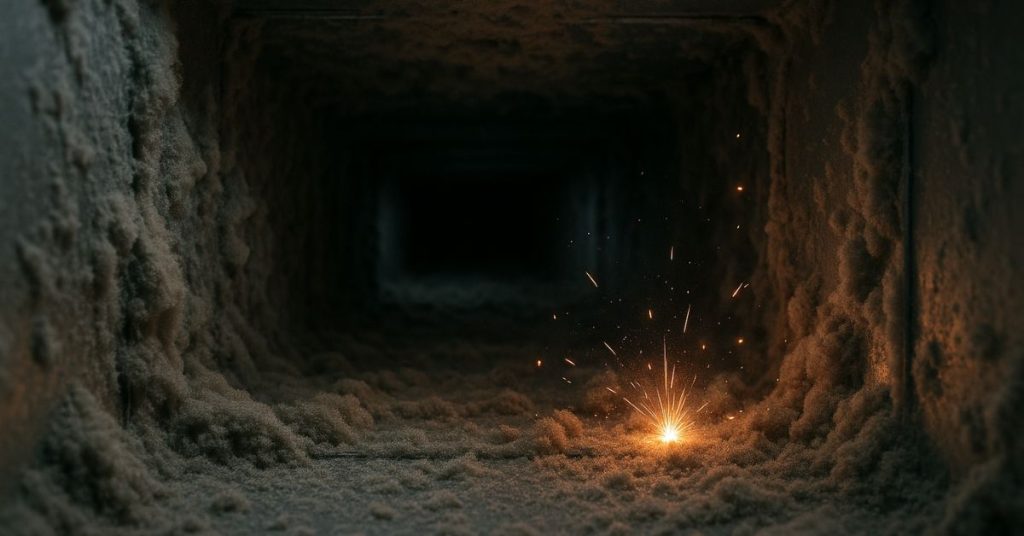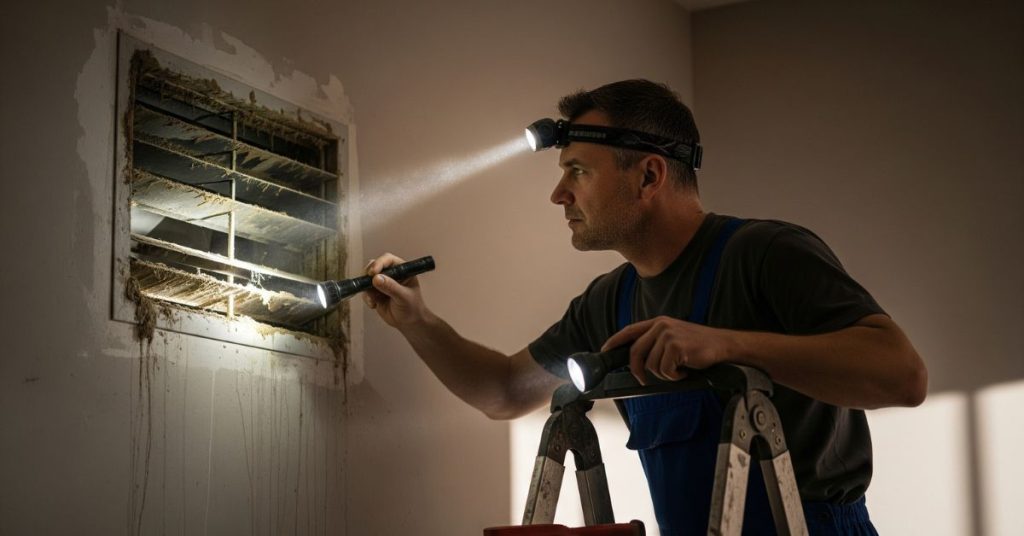Dirty air ducts accumulate dust, debris, and flammable particles that restrict airflow, overheat HVAC systems, and increase the risk of fire hazards caused by dirty air ducts, making regular cleaning essential for home safety.
Key Takeaways:
- Dirty ducts restrict airflow and cause overheating.
- Dust buildup increases flammability.
- Regular duct cleaning reduces fire risks.
In every home, hidden threats often go unnoticed—until it’s too late. Among the most overlooked dangers are dirty air ducts. These seemingly harmless pathways can become fuel for deadly house fires if left uncleaned and unchecked. Understanding how dirty air ducts contribute to fire risks is crucial for maintaining a safe, healthy living environment.
The Silent Threat: What Lurks Inside Your Air Ducts
Air ducts are responsible for circulating air throughout your home. Over time, dust, debris, pet dander, lint, mold spores, and even pests can accumulate inside them. What many homeowners fail to realize is that these materials are not only allergens—they are also highly flammable.
When air ducts are neglected, this debris can build up in thick layers, particularly in homes with older HVAC systems or those that use the heating system frequently during colder months. Once a system heats up or a spark occurs, these flammable materials can ignite rapidly, spreading fire throughout the ductwork and into multiple rooms in seconds.
How Fires Start in Dirty Ducts: A Hidden Ignition Pathway

Dirty ducts can act like a fuse running through your home. Here’s how:
- Overheating HVAC components: When filters are clogged and ducts are filled with debris, your HVAC system works harder. Motors overheat, and electrical components can short out—both of which can ignite nearby flammable buildup.
- Sparks from electrical faults: Ducts often run near or around wiring. If a wire sparks due to wear, rodents, or power surges, it can ignite dry lint and dust.
- Dryer duct cross-contamination: In some setups, dryer vents and HVAC ducts run close together. Lint from dryers is extremely combustible, and if it enters the HVAC system or isn’t vented properly, it significantly increases fire risk.
- Neglected chimneys and fireplaces: If a fireplace is connected to any part of the duct system or heating unit, embers or heat transfer can reach flammable duct debris, especially if insulation is compromised.
- Static electricity discharge: Dust particles moving through ducts can create static buildup. In rare cases, a static discharge can spark, igniting accumulated dust and lint.
- Blocked air vents and restricted airflow: Poor airflow can cause parts of the system to overheat, making nearby dust and debris more likely to ignite.
- Rodent or pest nesting: Rodents often chew wires and build nests inside ducts. Both chewed insulation and dried nesting material are highly flammable.
- Proximity to heat sources: If ducts pass too close to furnaces, boilers, or hot water heaters, the added heat can dry out and ignite dust buildup inside.
- Oil or grease residue: In homes with open kitchens, greasy particles can get pulled into ducts. Grease buildup is one of the most combustible materials when exposed to heat or sparks.
Real-World Incidents: House Fires Caused by Dirty Air Ducts
Across the United States, fire departments report thousands of house fires annually linked directly to HVAC and dryer vent issues. According to the National Fire Protection Association (NFPA), over 15,000 fires each year originate from heating equipment—many due to dust or lint ignition.
In multiple documented cases, families have lost homes and lives due to fires that started in poorly maintained ducts. These tragic incidents highlight the critical importance of regular HVAC system inspections and thorough air duct cleaning to prevent hazardous buildups.
Expert Insight:
John Martinez, a certified HVAC technician with over 20 years of experience in residential system maintenance, emphasizes,
“Neglected air ducts accumulate dust, lint, and debris that can easily ignite when exposed to the heat generated by HVAC components. Routine professional cleaning and inspections can reduce the risk of fire dramatically.”
Authoritative Sources:
The U.S. Fire Administration (USFA) also reports that improper maintenance of heating systems and vents is a leading cause of residential fires. Their guidelines strongly recommend annual duct inspections and cleaning as a key preventive measure.
These expert insights, backed by credible data and real-life cases, demonstrate the importance of trusting qualified HVAC professionals for regular duct maintenance to protect your home and loved ones.
The Dangerous Domino Effect of Neglect
Dirty air ducts don’t just pose a fire risk—they create a chain reaction of hazards:
- Blocked airflow makes the HVAC system overwork, leading to premature breakdowns and excessive heating of internal components.
- Pests like mice or birds often nest in ductwork. These nests are highly flammable and often chewed into by the animals, exposing live wires or insulation.
- Mold and mildew not only reduce air quality but also create moist, warm environments that contribute to material decay and electrical faults.
- Combustible insulation around ducts can catch fire if the surrounding buildup ignites, spreading flames quickly through the walls and ceilings.
Signs Your Air Ducts May Be a Fire Hazard
To prevent a disaster, watch for these red flags:
- A burning smell when the HVAC is running
- Visible dust clouds from vents
- HVAC system taking longer than usual to heat or cool
- High utility bills, indicating overworked systems
- Unusual noises in the ducts, possibly from animal activity
- Moldy odors, especially in humid conditions
- Frequent HVAC system shutdowns or circuit breaker trips
- Soot or discoloration around vents or registers
- Excessive accumulation of lint or debris near heating elements
If you notice any of these signs, immediate action is needed.

Professional Air Duct Cleaning: Your First Line of Defense
Having your air ducts professionally cleaned isn’t just about cleaner air—it’s about fire prevention. Certified HVAC technicians use high-powered vacuums, rotary brushes, and air whips to remove all accumulated contaminants. This process ensures that:
- Dust and lint are completely extracted
- Pest infestations are identified and removed
- Duct integrity is inspected, including insulation and seals
- Potential fire hazards are neutralized
Professionals also check the blower motor, heat exchanger, and evaporator coils, which are common ignition points if surrounded by flammable debris.
How Often Should You Clean Your Air Ducts?
Experts recommend a thorough duct cleaning every 3 to 5 years, but certain homes may require more frequent service, especially if:
- You have pets
- You smoke indoors
- There’s been construction or renovation
- You use the HVAC system year-round
- A family member has allergies or respiratory issues
Homes in wildfire-prone or dust-heavy regions should consider annual inspections to avoid soot or ash buildup, which also poses a combustion risk.
DIY vs. Professional Cleaning: What’s Best for Fire Prevention?
While there are DIY duct cleaning tools available, homeowners lack the equipment and expertise to identify fire risks hidden within the system. Incomplete cleaning often leaves behind hidden debris, which can still ignite.
Only professional cleaners can:
- Access deep bends and branches in the duct system
- Use HEPA-grade vacuums that trap fine particles
- Provide a full system audit and fire-risk evaluation
- Ensure compliance with NADCA (National Air Duct Cleaners Association) standards
DIY may be tempting, but when it comes to fire prevention, cutting corners is a risk you can’t afford.
Fireproofing Your HVAC System: Additional Safety Measures
Beyond cleaning, consider these added precautions:
- Install smoke detectors near HVAC units and duct exits
- Use metal ductwork over flexible plastic ones, which melt quickly
- Ensure all duct joints are sealed properly with fire-resistant tape
- Replace air filters monthly or as recommended
- Schedule annual HVAC maintenance inspections
- Keep dryer vents and chimney flues professionally cleaned as well
Who Should I Call for the Best Air Duct Cleaning Services Near Me?
When searching for the best air duct cleaning services near you, it’s crucial to choose professionals with proven expertise. Look for certified duct cleaning companies that:
- Follow NADCA standards for thorough cleaning
- Use high-powered, industry-grade equipment
- Offer full inspections for hidden fire risks
- Provide transparent pricing and service guarantees
For reliable air duct cleaning service, call the trusted experts at 5 Star Air. Our certified technicians ensure your ducts are spotless, safe, and fire-free.
Conclusion: Clean Ducts Save Lives
Your home is your sanctuary, but it’s also a complex system of hidden risks. Dirty air ducts present a serious air duct buildup fire risk, capable of turning a small spark into a devastating blaze. Through regular professional cleaning, smart fireproofing practices, and awareness of warning signs, you can protect your home, your investment, and your family.
Don’t wait for a disaster to take action. Contact us for duct inspection & heating & air conditioning maintenance today—and breathe safer knowing your home isn’t just comfortable, but secure.
